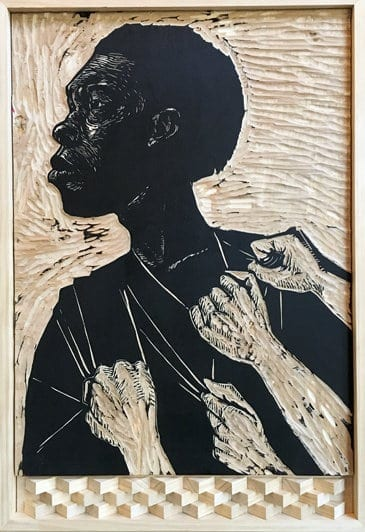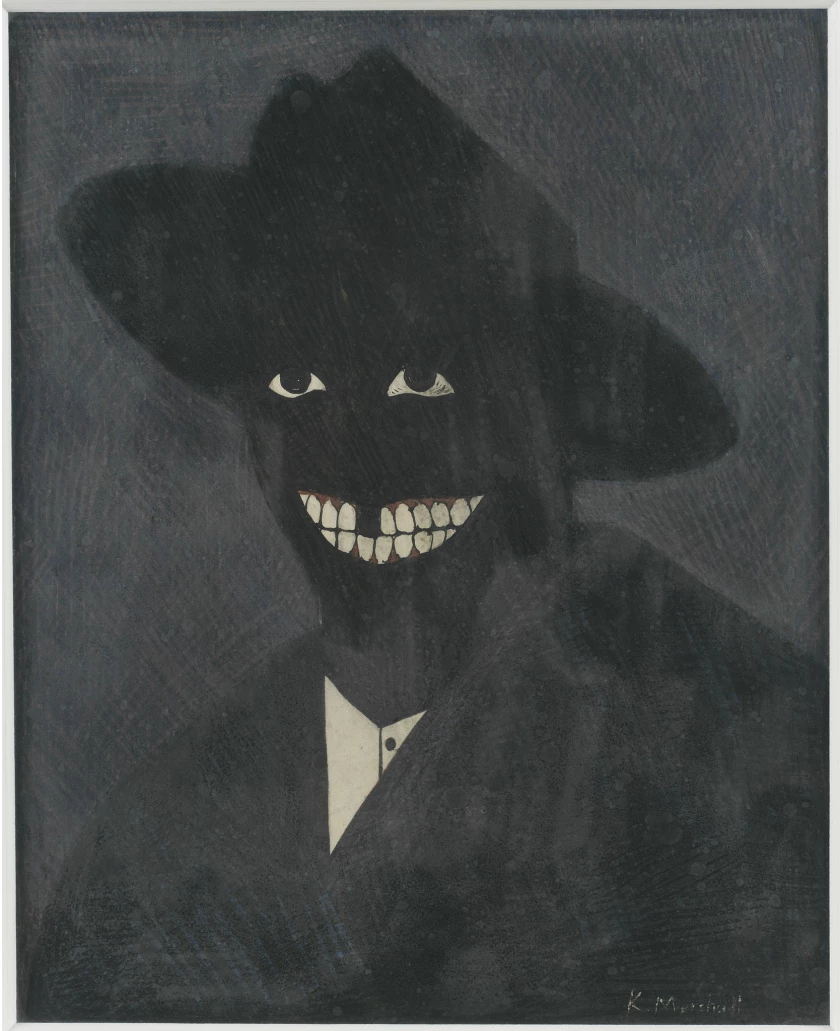Selection: “To Be Free” (2017)
- Artist: Jamaal Barber
- Art Form: Carved Wood Block
- Time Period: 21st Century

Biographical Profile of Jamaal Barber
Jamaal Barber is a modern African American artist specializing in printmaking and woodcuts. The artist was born in Virginia and raised in Littleton, North Carolina (“Jamaal Barber”). He showed interest in art from a young age, fascinated by images in children’s and comic books. Then, Barber started drawing in elementary school and would draw on anything he could find (“Jamaal Barber”). However, Barber’s early passion would not lead him to become a full-time artist.
Barber’s major in college was business, but he switched it to art. Barber realized that he wanted “to make this art stuff work” when he had taken a “drawing class as an elective” (Johnson). Barber won several ECU student art awards during his years at East Carolina University. Notably, he won the JOSA Award of Excellence in Drawing in 2002 and got first place in the graphic design competition of the Rebel Magazine (“Jamaal Barber”). In 2003, Barber graduated from ECU with a bachelor’s degree in Communication Arts and took a 15-year break from studying to foster his personal view of artistry (“Jamaal Barber”; Johnson). In 2004, Barber moved to Atlanta, Georgia, and resides there with his wife and kids (“About”). The artist was actively creating during the break while working as a graphic designer for Iota Phi Theta Fraternity, Inc. and Spoken Magazine. His works have been displayed at the Ao5 Gallery and the Mano A Mano art show (“Jamaal Barber”).
Furthermore, Barber’s works have been published by Penguin Random House, Black Art in America, and Emory University, as well as on social media platforms and in the New York Times (“About”). From 2018, Barber went for a master’s degree in Printmaking at Georgia State University. His focus on printmaking began when he saw a demonstration on making a screen print at a local art store in 2013 (“About”). The artist’s prints and woodcuts are displayed at ZuCot Gallery and have been part of various art shows such as the Decatur Arts Festival and the Atlanta Print Biennial exhibit (“About”). In his works, Barber explores Black identity and showcases aspects of African American life (Johnson). His pieces are dynamic, thought-provoking, and experimental, depicting the perception of African Americans by themselves and society.
Critical Analysis of “To Be Free”
I selected one of Barber’s recent woodcuts because it showcases the social reality in which many African Americans live to date. The theme of the piece is the desire and struggle for freedom. The carving consists of a black man looking to his right and four white hands holding him by the shirt. The man’s expression is calm and thoughtful, indicating that he sees desired destination and is unconcerned with the impediment. He seems to be in motion: he starts moving towards the said destination. The hands are clenched and tense, stretching and nearly tearing the man’s clothing. It shows how they try to stop the man no matter what. The contrast between calmness and aggressiveness is striking and indicates a contest of persistence with the sheer power of reality. The artist has used a contrasting black and white palette that enhances said competition. Barber’s art piece from the same exhibition says: “Black is never neutral.” Interestingly enough, black is defined as a neutral color, but the artist makes it non-neutral in his piece. ‘To Be Free’ implies that black is a resistance surrounded by heavy and oppressing whiteness.
I think that Barber wants to show the hegemony of white America over the perception of black people. Tariq notes that Barber brings to light how “blackness is hyper-visible only when it is not seen as a threat to white wealth, power, privilege and safety.” The piece depicts how white society often attempts to dictate the freedom of a black person, employing discriminating views, stereotypes, and boundaries. Another implication that can be made is that the hands pulling the clothes will only receive the clothes. Historically, clothes were symbolic of status and caste in society. The man is determined to escape, and his body will not be taken, but he may lose his clothing. Here, the clothes seem to be the man’s false skin, the symbol of perception of himself and his place in society imposed by said society.
I would classify the piece as black art because it questions the harsh reality of African Americans in modern times. The exhibition is called Bright Black, and it revolves around what Barber sees as “the American Color Theory” and breaking “hegemonic modes of seeing” of black people by society (Tariq). Barber propagate African Americans to be strong and unflappable like the man on the carving. The will of the individual, the man, overshadows society’s discriminating imposition, the hands. They have grabbed a strong individual by his imposed identity, and the man has complete control over the situation. To be free, he needs to let go of so-called ‘hegemonic modes of seeing’ and be true to himself.
Selection: “Portrait of the Artist as a Shadow of His Former Self” (1980)
- Artist: Kerry James Marshall
- Art Form: Paper Painting
- Time Period: Postmodernism/New Blackness

Biographical Profile of Kerry James Marshall
Kerry James Marshall is an African American painter and printmaker. He was born in Birmingham, Alabama, in 1955 (Yood). The artist is known for his unique style, representing ordinary people and questioning social dogmas. Marshall studied at the Otis Art Institute in Los Angeles and got his Bachelor of Fine Arts in 1978 (Yood). Marshall used a collage technique in his early works and was actively creating in the 1970s. However, the turning point for his career came in 1980 with the ‘Portrait of the Artist as a Shadow of His Former Self’ (Easter). It was the first of Marshall’s famous black figures that have become characteristic of his style.
Marshall has been living in Chicago most of his life. He moved there with his future wife, Cheryl Lynn Bruce, in 1987 after he finished a residency for the Studio Museum in Harlem. In Chicago, he worked as a professor at the University of Illinois from 1993 to 2006 (Yood). During this period, the artist made numerous paintings and series depicting the life and culture of African Americans and the social issues they face and received several awards. MacArthur Foundation gave Marshall’ Genius Grant’ in 1997, and Otis Art Institute awarded him with an honorary doctorate in 1999 (Yood). Other honors include a fellowship from the National Endowment for the Arts (1991), Wolfgang Hahn Prize (2014), Rosenberger Medal (2016), Chicago’s Fifth Star Award (2017) and WEB. Du Bois Medal (2019) (“Kerry James Marshall: Biography”). In 2013, Marshall was appointed to the President’s Committee on the Arts and the Humanities. The artist has been widely praised for his influence on US culture and art.
Marshall’s works have been exhibited not only in the US but in Europe too. Numerous museums and art centres in Chicago, Los Angeles, New York, Washington, San Francisco, Minneapolis, and Boston hold his paintings in their collections. For example, Chicago’s Museum of Contemporary Art or Washington’s National Gallery (“Kerry James Marshall: Biography”). Other well-known institutions throughout the US have been organizing solo shows since the late 1990s. Abroad exhibitions have been held in Vancouver, Vienna, London, Kassel, Venice, Antwerp, Copenhagen, Barcelona, and Madrid. The most prominent displays were Documenta in Kassel in 1997 and 2007, the Venice Biennale in 2003, and David Zwirner in London in 2014 and 2018 (Yood; “Kerry James Marshall: Biography”). Additionally, the artist was commissioned to create a grand mural for the High Line in 2015. Such presence in museums and galleries and the number of awards and honors clearly show an immense contribution that Marshall has made to the art world and for the representation of African Americans worldwide.
Critical Analysis of “Portrait of the Artist as a Shadow of His Former Self”
I chose one of the most famous works by Marshall, ‘Portrait of the Artist,’ because it is crucial for the development of the artist’s unique style and thematic focus on African American life and culture. The painting is a metaphorical depiction of white America’s unfair perception of black people. The artist painted the ‘self-portrait’ on a tiny piece of paper (8 by 6½ inches) using egg tempera (Easter). The painting depicts a black figure looking at the viewer with a big toothy smile. The figure wears a black hat and coat and stands over a black background. The piece is predominantly black with some grey-white for shirt, teeth, eyes, and dark red for gums.
The smallness of the piece creates an interesting illusion. First, while at some distance, the viewer sees only blackness with some white spots. The shirt, eyes, and devilish grin become visible, moving a little closer. Finally, shades of black emerge, and the shadow becomes a smiling person in dark clothing. Moreover, the smile no longer seems malevolent or mischievous; the person is cheerful, and the image is perceived as optimistic. Easter argues that some might see a connection between the piece and the racist practice of blackface, but Marshall, most probably, did not intend to make such connections. The artist painted a black figure over a black background to show how individuals may be present but ignored by others. This concept is relevant today more than ever as societies, groups of people or individuals tend to ignore those they deem unworthy based on some biases, which is discrimination at its core.
Marshall was inspired by Ralph Ellison’s novel Invisible Man written in 1952. Ralph Ellison explores “the harsh indignities of being a black in America,” being virtually non-existent in the eyes of white people because of skin color (Easter). Furthermore, ‘Portrait of the Artist’ was Marshall’s experiment with black paint. White notes how black is “as chromatically rich as every other color on the spectrum” in Marshall’s works (as cited in Easter). The experiment’s success gave the world dozens of brilliant paintings that depict the richness of African American culture and raise awareness about issues that African Americans face daily. That is why I believe that ‘Portrait of the Artist’ is an important contribution to black art.
Works Cited
“About.” JBarberStudio, Web.
Easter, Makeda. “LACMA acquires Kerry James Marshall’s haunting, potent portrait of a Shadow of His Former Self.” Los Angeles Times, Web.
“Jamaal Barber.” Artcloud, Web.
Johnson, Norman V. “Visual Artist Jamaal Barber Making Mark in Worlds of Art and Education.” Rolling Out, Web.
“Kerry James Marshall: Biography.” David Zwirner, Web.
Tariq, Malcolm. “Review: In His First Solo Show, Artist Jamaal Barber Presents a Black So True It’s Bright.” ArtsATL, Web.
Yood, James W. “Kerry James Marshall.” Encyclopaedia Britannica, Web.